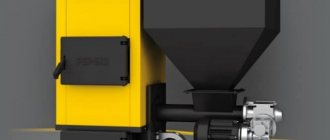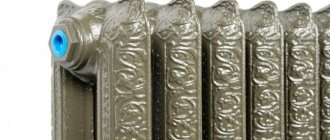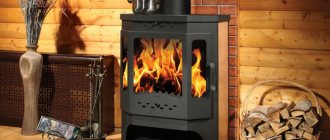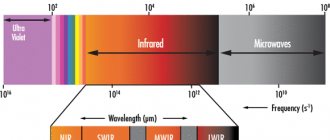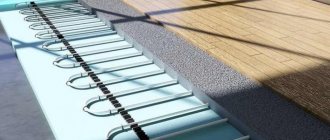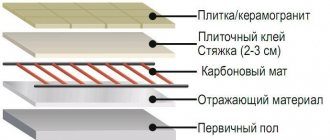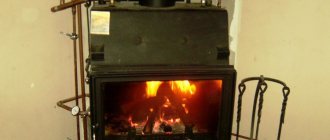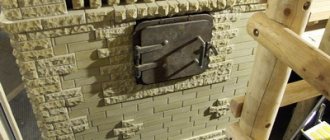Relatively recently, a new type of heating equipment appeared on Russian markets - the so-called warm baseboards. In domestic housing they are still not often found, while in foreign countries they have become a sustainable alternative to classic heating systems. However, this system has many opponents both in its native country and abroad who believe that full-fledged heating with such equipment is impossible. The main argument is the fact that the area of the heating devices is small. In turn, there are those who call this disadvantage an advantage. Thus, it is necessary to understand all the pros and cons of warm baseboards.
Operating principle and design of warm skirting boards
Indeed, a warm baseboard can be called a “new word” in the matter of heating all types of homes - from apartments to private houses. This heating system got its name due to its resemblance to a regular baseboard and due to its small dimensions. Visually, the design consists of:
- Aluminum box, including three walls - front, bottom and top;
- The thickness of the box itself does not exceed 3 centimeters;
- The height of the front panel can be from 10 to 24 centimeters;
- For decoration purposes, the end parts of the box are covered with special plugs;
- The box inside is equipped with heating elements that are attached to the wall of the structure using mounting brackets.
Depending on the heat source used in the system, skirting boards can be electric or liquid (they are practically the same in appearance). The operating principle of thermal baseboards is fundamentally different from traditional convection heating equipment - heating radiators/convectors.
Traditional heating equipment (the same radiators) heats the room by convection. This means that the heat emanating from the heated external parts of the battery warms the surrounding air. Moreover, the heated air rises closer to the ceiling, where it forms a special air cushion, while simultaneously displacing cold masses lower, closer to the floor. In rooms where the ceilings are low, the difference between the cool floor and the hot under-ceiling space is not so noticeable, so a person feels quite comfortable there. However, in rooms with high ceilings the difference is very noticeable and therefore forced ventilation has to be done there - only in this way is it possible to mix the available warm and cold air masses to achieve a comfortable temperature. At the same time, despite forced ventilation in the corners of a room with high ceilings, the air will remain unheated. Thus, to achieve a greater effect, a banal increase in heating temperature and a longer period for heating the room are required. Heat loss in this case ranges from 20 to 30%. For clarity, we can give the following example: if you turn on an oil heater in a cool room, then at a short distance from it the air will quickly warm up, but a little further away it will remain cold for a long time.
The effect of a warm baseboard is based on the uniform and gradual heating of all nearby walls and floors. The convection method of heating the surrounding air near the baseboards requires no more than 30% of all resources. Heating of the room begins from the layers of air closest to the floor, then smoothly moves up the walls, simultaneously heating their surface. Thanks to this heat distribution scheme, it is possible to achieve equal heating of the room throughout its entire volume. Moreover, rising along the walls, the heated air does not mix with the surrounding air, creating a kind of thermal “curtain”. This heating method is extremely relevant for rooms with panoramic windows, because cool air that can enter through unsealed joints is simply cut off without cooling the room.
Statistics say that heat loss when using warm baseboards is only 5%. It has been scientifically proven that if the walls of a room are heated to 37-38 degrees Celsius, and the overall temperature of the room is at 16-17 degrees, then a person no longer feels cold or any discomfort at all. From this it can be seen that heating baseboards can easily be used as a full-fledged heating system. They can be mounted along the general perimeter of the room or only in certain places.
The skirting boards in question are extremely functional, because they can be installed in places where it is not possible to install a regular radiator. A good example here is loggias with French glazing (the wall of the loggia is solid glass).

Most domestic buyers are wondering whether the furniture, which is often placed in apartments near the walls, will suffer from the operation of a warm baseboard? It should be noted here that the operation of the heating system in question is not aimed at heating the surrounding air and objects adjacent to the walls, so they will not interfere with each other. In addition, heating elements have an operating mode at low temperatures, which means they heat up no higher than 60 degrees Celsius, so they cannot cause damage to furniture cladding and its covering, as well as flooring. Thus, we can conclude that warm skirting boards are systems that are extremely economical and safe.
Skirting boards with electric heating
Electrical samples of the equipment in question are more widely popular, unlike liquid ones. This is due to a simpler installation scheme and due to the fact that access to electricity is available even in the most remote areas, but finding the nearest water supply can be more difficult. According to the principle of operation, the design of a warm baseboard is akin to a “warm floor”:
- In the inner part of the box there are two metal (usually copper) tubes with a diameter of about 13 millimeters and a wall thickness of one and a half millimeters. Brass “ribs” are tightly seated on these tubes. The tube, which is located lower, contains a low-temperature heating element;
- Hidden inside the first tube is a heat-resistant electrical cable, insulated with silicone, which is responsible for feeding the heater;
- Due to the fact that copper/aluminum are excellent heat conductors, tubes are made from the former, and front panels are made from the latter. This combination of alloys allows for maximum heat transfer;
- In addition, the system can be equipped with temperature sensors and thermostats. Due to the latter, it is possible to achieve significant savings throughout the entire system - with its help, you can maintain a certain temperature for several days in advance (for example, set the minimum values when the room is not supposed to be used).
IMPORTANT! The thermostat sensor should be placed at a height of 130 to 150 centimeters from the floor in order to obtain the most accurate temperature readings. When the temperature reaches the set level, the heating system will turn off. And it will turn on again when the temperature reaches the minimum permissible level.
The length of each electric baseboard module, as a rule, ranges from 70 centimeters to 2.5 meters. Based on these dimensions, it is possible to assemble the required heating circuit of the required power and the required perimeter. Average indicators say that one linear meter of such a system is capable of producing from 180 to 280 watts of heat. It is always worth remembering that for the safe operation of such a heating system, it must be connected to fully functional and new electrical wiring. For convenience, manufacturers recommend laying a separate power line for the baseboards, leading it directly to the meter and installing your own machine.
Skirting boards for water heating
In their operation, water baseboards are most similar to water boilers. Their structure differs significantly from electrical samples:
- Such skirting boards do not heat coolants on their own - they use already heated substances (they can be either plain water or a special liquid, for example, antifreeze);
- The coolant flows through tubes located inside the box, which are made of cross-linked polyethylene;
- There are two pipes in the box, they are installed one on top of the other, despite the fact that the coolant fluid is taken in through the bottom pipe, and it is supplied through the upper pipe.
Due to the fact that sufficient pressure is required to transfer the heating substance through the system, in private houses special circulation pumps are used for these purposes. Through them, the coolant flows under a set pressure through the distribution manifold and is then supplied to the heating modules.
IMPORTANT! In the case where the connection point of the pipes in the baseboard box for water heating is at the corner of the room, then special corrugated or polyethylene “corners” are used to connect the system. It is worth remembering that for proper operation of water circuits, their length cannot exceed 12.5 meters - otherwise heat will be wasted irrationally. However, if the perimeter of the room is much larger than this figure, then it is preferable to install two or more separate circuits.
The temperature in water models can also be adjusted using a thermostat or manually at the distribution manifold. If a thermostat is used, then automatic servos will be responsible for opening/closing the valves.
To summarize, we can conclude that organizing a heating circuit in water-based baseboards is very expensive. This is due to the fact that not only the installation of a pump and manifold is required, but also ensuring reliable storage of coolants and their cleaning. Therefore, Russians prefer electric models.
Connecting a water baseboard in a city apartment
In principle, this option is possible, but it does not occur often. This is due to the need to connect the system to central heating, and water hammer can often occur in it, which may not withstand the tubes in the structure. Moreover, the temperature of the water in the batteries ranges from 85 to 90 degrees Celsius, and the pressure can reach 9 atmospheres or more. All these factors also lead to the destruction of individual elements of the entire heating structure.
Still, there is a way to minimize the above-mentioned risks - the whole trick will be to separate the heating circuit from the central network:
- It is necessary to use heat exchangers, i.e. devices through which a certain part of the excess heat will be taken from the heat-carrying substance. In the future, these excesses can be transferred to another internal and independent circuit;
- Typical apartments have riser wiring installed, so each room can have a one- or two-pipe riser. Thus, the connection can be made using copper fittings by soldering or plastic tubes together with fittings. With this method, restrictions on the temperature and pressure of the heat-carrying substance are removed;
- Connection to the heating baseboard drain can be done using a thermal valve.
How does the “Warm baseboard” system work?
A system of heating modules is installed along each external wall using special decorative casings. These modules consist of paired copper pipes. They are fitted with ribbed plates, which are most often made of brass. When water heated to a high temperature flows through a copper pipe, heat from it goes to the radiator plate. They, in turn, give off this heat to the air that is near the surface. A physical process is triggered, which is called the aerodynamic Coanda effect: warm air rises and heats the walls, and they heat the entire room. Typically, such modules are connected into groups, which are also called circuits. The length of each of them should not exceed 12.5 m.
Heating "Warm baseboard" guarantees:
- preventing heat leakage from rooms thanks to thermal air screens located in front of each window and external wall;
- heating the room using technology that is not capable of harming the human body and is perceived by it in the same way as solar heat;
- dry and warm walls in the house, which are perceived much better than heated air on cold and damp surfaces.

Advantages and disadvantages of warm skirting boards
The undoubted advantages of using the heating system in question can be confidently called:
- Due to the fact that heat rises along the walls and warms them up perfectly, the problem of fungus or mold can be considered solved once and for all (dry walls are the main guarantee that they will not be damaged by fungal microorganisms).
- Heating of the serviced room is carried out simultaneously around the entire perimeter and evenly, which allows you to avoid waiting for the heat from the coolant to disperse throughout the room. It is this factor that leaves standard radiators at a disadvantage.
- It is possible to achieve an equal temperature throughout the entire volume of the room, while there will be no “cold sectors” left. Practice shows that the difference in temperature under the ceiling and near the floor is no more than a degree. However, it is worth remembering that the effective operation of the entire structure will also depend on proper thermal insulation of the room itself and on possible heat loss.
- Heating occurs by radiation, which is considered the safest for the human body, because it is perceived by it as receiving solar heat.
- The maximum amount of heat loss is only 5% (while for heating using the convection method this figure is up to 30%).
- Warm skirting boards are compatible with any type of flooring.
- A moderate temperature is constantly maintained in the device box itself, so there is no need to worry about the safety of furniture standing nearby (it will dry out).
- Installation of the entire system involves maintaining the aesthetic appearance of the entire room, which cannot be said about installing bulky radiators.
- Due to the small dimensions of the structure, it can be used to heat rooms where it is simply impossible to install radiators and radiators.
- Adjustment of the temperature in the circuit is carried out at an intuitive level using thermostat switches and temperature sensors (modern systems can even perform user-preprogrammed actions).
- The entire system is an example of saving on home heating.
However, there are also significant “disadvantages”:
- The cost of such a design is quite high.
- Skirting devices are not yet popular enough in Russia, so it is sometimes difficult to find not just spare parts for the structure, but even specialists for their installation.
- Apart from special samples, most baseboard heating systems are extremely susceptible to high humidity in the premises served. High humidity can lead to premature wear of individual elements.
- The entire structure is limited in the length of the heated perimeter (12.5 meters) - and installing a second and even third circuit for just one room is far from cheap.
Warm electric baseboard
Most often, people who want to build a private house for themselves choose this method to heat it. Warm electric baseboards are an environmentally friendly energy source. For its installation, a single-wire or two-wire cable is used. If you choose a single-wire resistive cable, then you will only need one conductor with high resistance. Double layer cable requires the use of copper conductor in addition to resistive conductor.
Warm electric baseboards have a number of positive aspects:
- with its help you can maintain a high temperature for a long time;
- it does not have filters, which are known to become clogged;
- the electrical cable is not afraid of leaks;
- when you turn on such heating, you do not need to wait long for the room to heat up - it happens very quickly;
- The heating system is absolutely safe because it works automatically.
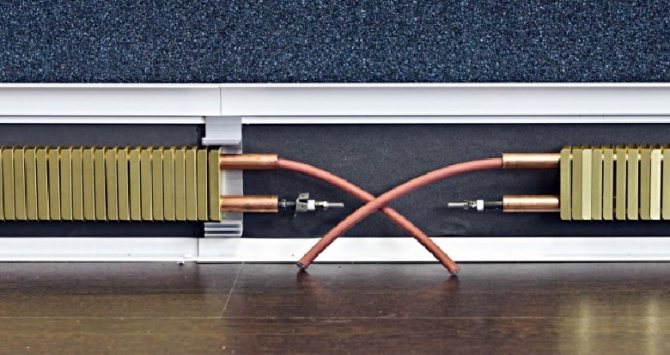
Modern types of warm baseboards can be adjusted not only using remote controls, but also from a distance, using SMS messages. In this way, you can save energy when you are away and turn on the heating system shortly before your arrival using remote control.
Rating of the best warm skirting boards for 2020
Budget samples
2nd place: “Orion” 530 mm
This economical model is distinguished by high reliability and the absence of the need to install shut-off fittings. The sample works like a standard battery, but its heat loss is 6 times less. The body of the device is coated with a special protective compound, which stably protects it from possible corrosion. Can be used around the perimeter of swimming pools and on balconies with French glazing (panoramic windows).

| Name | Index |
| Heater type | Electric |
| Heating power, Watt | 75 |
| Control | Electronic |
| Section length, millimeters | 533 |
| Material | Aluminum |
| Price, rubles | 2700 |
Orion" 530 mm
Advantages:
- The box is treated with a special compound;
- Possibility of installation at different sites;
- Budget cost.
Flaws:
- Thermostat is missing.
1st place: “Cozy” 1050 mm
Powerful and reliable model. It can be installed either as the only heating element in small rooms or included in heating circuits. Provides residents with special comfort: it does not dry out the air, does not fill it with combustion products, and does not create dust circulation in the room being served.

| Name | Index |
| Heater type | Electric |
| Heating power, Watt | 320 |
| Control | Electronic |
| Section length, millimeters | 1050 |
| Material | Aluminum |
| Price, rubles | 3600 |
Cozy" 1050 mm
Advantages:
- Large range of body color variations;
- Increased power;
- There is a thermostat for adjustment.
Flaws:
- Afraid of high humidity.
Mid-range models
2nd place: “Orion 1 Cedar”
This model has an extremely pleasant appearance and can be used as a design element when decorating a country house. Sufficient power of this circuit will allow you not to freeze in the coldest times of the year. This sample is characterized by the production of rather long structural elements, which makes it possible to equip them with large perimeter rooms.

| Name | Index |
| Heater type | Electric |
| Heating power, Watt | 150 |
| Control | Electronic |
| Section length, millimeters | 1000 |
| Material | Aluminum |
| Price, rubles | 3800 |
Orion 1 Cedar
Advantages:
- Aesthetic appearance;
- Increased power;
- Simplified installation.
Flaws:
- Again there is no thermostat.
1st place: “Mr. Tektum 2.0"
Another model designed for design projects. The heating device is made of hot-pressed aluminum alloy, inside of which brass and copper pipes are installed. Due to the fact that the model is liquid, installation is best done after preliminary heat calculations. Most experts recommend using this plinth for cottages and country houses.

| Name | Index |
| Heater type | Liquid |
| Heating power, Watt | 600 |
| Control | Manual |
| Section length, millimeters | 2000 |
| Material | Aluminum alloy |
| Price, rubles | 8600 |
Mr. Tektum 2.0
Advantages:
- High power for liquid instrument;
- Use of special alloys in construction;
- Recommended for design projects.
Flaws:
- High price;
- Difficult to install.
Premium class
2nd place: “Thermodul 13.17”
A rare representative on the Russian market of a line from a Western manufacturer. It is distinguished by the variability of the materials used and its high price. Import and trade into the Russian Federation is possible only with a certificate of conformity. Relatively difficult to install and requires original components for repair. It is better to entrust the installation of such equipment to professionals.

| Name | Index |
| Heater type | Liquid |
| Heating power, Watt | 500 |
| Control | Thermostat |
| Section length, millimeters | 1000 |
| Material | Aluminum alloy |
| Price, rubles | 16500 |
Thermodul 13.17
Advantages:
- The model is controlled by a thermostat;
- The design uses an innovative alloy;
- The warranty period has been extended.
Flaws:
- Very high price per linear meter (in the absence of other advantages).
1st place: “Thermodul Combi”
Another expensive model from the Italian brand. It justifies its extremely high price (30,000 rubles/l.m.) 100%, due to the fact that it has a combined operating mode: it can work on both electric coolant and liquid coolant. However, it requires professional installation and adjustment of the entire circuit. The control is fully automated.

| Name | Index |
| Heater type | Liquid/Electric |
| Heating power, Watt | 650 |
| Control | Thermostat, fully automatic |
| Section length, millimeters | 1000 |
| Material | Aluminum alloy, corrugated |
| Price, rubles | 30000 |
Thermodul Combi
Advantages:
- Combination of operating modes;
- Fully automatic control;
- The latest materials in construction.
Flaws:
- Not identified (for its characteristics).
Warm infrared baseboard
This is the newest option for heating surfaces, which was discovered quite recently. It is based on infrared radiation, for which a special film is used to display it. It consists of strips, which are created using carbon conductors embedded in a polymer film. The film used for heating should be 0.4 millimeters thick. It is quite easy to install and does not require a screed. Warm infrared baseboards do not create radiation that can harm human health. It is financially beneficial. The only thing that needs to be taken into account with this heating option is that not all floor coverings can withstand such heating. Therefore, if you have settled on this particular option for a warm baseboard, when choosing a material for the floors, consult with consultants. In this case, a parquet floor or a floor covering with varnish will definitely not be suitable.

It is quite possible to install the film yourself, since this task is quite easy to complete. It is this type of installation of warm baseboards that is usually chosen by progressive people who closely follow all the innovative inventions of mankind and like to independently evaluate their advantages.
Instead of an epilogue
An analysis of the Russian market for warm skirting boards showed that domestic buyers prefer domestic models. This is all thanks to the fact that searching for components for them is not burdensome, and some samples can be assembled independently. And even their apparent simplicity does not make them something of low quality in the eyes of a potential user. On the contrary, most Russian models are well balanced in terms of price/quality parameters. At the same time, foreign samples can cost many times more (or even tens of times), however, even due to their perfection and the use of new technologies in them, they are not in particular demand in the Russian Federation.
